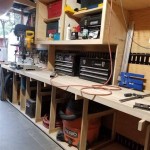How To Make A Garage Storage Shelf
Garages often become repositories for a multitude of items, leading to clutter and disorganization. Implementing effective storage solutions, such as sturdy, well-built shelves, can transform a chaotic garage into a functional space. This article provides a comprehensive guide to constructing a robust and practical garage storage shelf.
Planning and Preparation
Careful planning is essential for a successful project. This involves assessing the available space, determining the intended shelf load, and gathering the necessary materials and tools.
- Measure the space: Accurately measure the width, depth, and height of the designated area for the shelf. This will dictate the shelf's dimensions.
- Determine load requirements: Consider the weight of the items intended for storage. Heavier items will necessitate stronger materials and construction techniques.
- Choose materials: Common choices include plywood, solid wood, or medium-density fiberboard (MDF) for shelves, and dimensional lumber (2x4s or 4x4s) for supports. Select materials appropriate for the intended load.
- Gather tools: Essential tools typically include a measuring tape, saw (circular saw or hand saw), drill, level, safety glasses, and hearing protection.
- Create a design: Sketch a simple design of the shelf, including dimensions and placement of supports, to serve as a guide during construction.
Building the Frame
The frame provides the structural integrity of the shelf. A well-built frame is crucial for stability and load-bearing capacity.
- Cut the lumber: Using the measurements from the planning stage, cut the lumber for the vertical supports and horizontal beams.
- Assemble the frame: Connect the vertical supports and horizontal beams using screws and wood glue for added strength. Ensure the frame is square using a carpenter's square.
- Add bracing (optional): For additional stability, especially for heavier loads or taller shelves, consider adding diagonal bracing to the back or sides of the frame.
Installing the Shelves
The shelves form the platform for stored items. Secure and level installation is key for functionality and safety.
- Cut the shelf material: Cut the chosen shelf material (plywood, MDF, etc.) to the desired dimensions. Ensure a snug fit within the frame.
- Attach the shelves: Securely attach the shelves to the frame using screws. Ensure the shelves are level using a level during installation.
- Consider shelf supports: For increased load capacity and to prevent sagging, consider adding additional supports underneath the shelves, such as shelf brackets or smaller cross beams.
Finishing and Mounting
The final steps involve finishing the shelf for durability and mounting it securely to the wall.
- Sanding and finishing (optional): Sand any rough edges and apply a finish, such as paint or sealant, to protect the wood and enhance its appearance.
- Mount to the wall (optional): If desired, mount the shelf securely to the wall using appropriate fasteners, such as lag screws and wall anchors. Ensure the wall anchors are suitable for the wall type and anticipated load.
- Safety considerations: When mounting to the wall, ensure the shelf is securely attached to wall studs for maximum stability. Use a stud finder to locate wall studs accurately.
Material Alternatives and Considerations
Alternative materials and construction techniques can offer variations in cost, aesthetics, and functionality.
- Metal shelving units: Pre-fabricated metal shelving units offer a quick and easy solution, though they may lack the customization options of building from scratch.
- Reclaimed wood: Using reclaimed wood can add a unique character to the shelf while promoting sustainability.
- Heavy-duty options: For extremely heavy loads, consider using steel beams and thicker plywood or even concrete board for the shelves.
Optimizing Storage Space
Maximizing the storage capacity and functionality of the shelf requires strategic organization and utilization of space.
- Use storage bins and containers: Utilize storage bins and containers to organize smaller items and maximize vertical space.
- Labeling system: Implement a clear labeling system on bins and containers to easily identify stored items.
- Vertical dividers: Use vertical dividers to create compartments within the shelves for better organization of items.
Safety Precautions
Prioritizing safety throughout the construction process and during usage is paramount.
- Eye and ear protection: Always wear safety glasses and hearing protection when using power tools.
- Proper ventilation: When working with finishes or paints, ensure adequate ventilation.
- Secure mounting: Ensure the shelf is securely mounted to the wall if applicable, to prevent accidents or collapse.
- Load distribution: Distribute weight evenly across the shelves to prevent overloading and maintain stability.

How To Build Shelving In A Garage Three Ways Ana White

And Easy Diy Garage Shelves Building Plans Pneumatic Addict

Easy Diy Garage Shelves With Free Plans Fixthisbuildthat

Best Diy Garage Shelves Attached To Walls Ana White

Super Efficient 2x4 Garage Shelves Diy Storage

How To Build Diy Garage Storage Shelves Crafted Work

How To Build Garage Shelving Easy And Fast

How To Build Oversized Garage Storage Cabinets

Simply Easy Diy Garage Storage Shelves

Diy Garage Shelves 5 Ways To Build Yours Bob Vila
Related Posts








